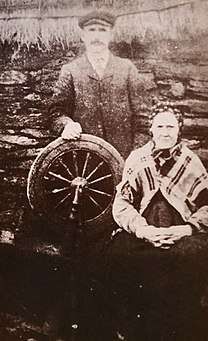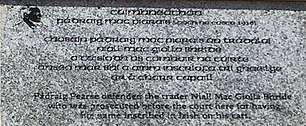Neil McBride (poet)
Neil McBride (Irish: Niall Mac Giolla Bhrighde; 1861–1942) was a farmer, poet, author, and songwriter from Feymore, Creeslough, Donegal, Ireland, who further gained notoriety for protesting a fine he received for having his name written in Irish on his business cart.

Farmer and poet
Neil McBride spent his entire life in the small village of Feymore, Creeslough, He lived on Crockatee (Cruckathee), a foothill of Muckish Mountain and earned his living as a cottier (farmer) and a poet. Neil published a book of poems in 1905 called Blaṫa Fraoiċ ('Heather Blossoms').[1] Neil's poems and songs became well known throughout Ireland. Some titles include: "The Hills of Donegal",[2] "Noreen Bawn" (1910),[3] "The Castle of Doe",[4] "Marble Hill" and "Mo Chró Beag ag Bun Chnoc a' Tighe" ("My wee shack below Crockatee") [5]
Historic encounter with the law
McBride was a farmer by trade and all business carts were required to display its owner's name in English. On the evening of March 11, 1905, returning home from the Dunfanaghy Fair, in a nearby town, McBride was stopped and questioned by an English 'bobby' who fined him one shilling for having 'illegible' (Irish) writing on his donkey cart. The sign defiantly read, "N. MAC GIOLLA ḂRIĠDE FIOḊ-MÓR" in Irish. It was made by McBride 's friend and fellow poet, Andrew Mac Intyre. McBride refused to pay the fine and defended himself at the Dunfanaghy Petty Session. He lost, and was penalized an additional shilling after still refusing to pay.
The Conradh na Gaeilge ("Gaelic League") learned of McBride 's story and made efforts to help him. One of its members, attorney Patrick Pearse, seeing the opportunity to champion Irish independence, agreed to defend McBride, pro bono. McBride's appeal was brought before the Court of King's Bench in Dublin. It was Pearse's first and only court appearance as a barrister. The case was lost, but it inspired Pearse in his endeavors as a political activist and spawned a national campaign to change British government policies towards the Irish language.[6] Pearse wrote about the court's decision in his June 27, 1905 column in the Gaelic League newspaper, An Claidheamh Soluis: "...it was in effect decided that Irish is a foreign language on the same level with Yiddish." Continuing in the article, he urges the people of Ireland to promote the Irish Language as a form of Irish nationalism.[7][8]
Legacy

Literature
- Creeslough historian and author, Seamus Harkin featured Neil's poetry and songs in his 1996 book, ‘Poets and People of Doe’[9]
- Neil published a collection of his songs and poems in 1905 in a book called 'Blaṫa Fraoiċ’ (‘Heather Blossoms’) Songs in Irish and English by Niall Mac Giolla Bhrighde.[1]
- In 2011, Seamus Harkin updated and reissued 'Blaṫa Fraoiċ’ , adding two extra songs, which Neil had composed after the original book was published. At the book's unveiling Seamus stated, "My reason for printing this book is to let people, especially the young, know the great wealth of talent we had in the parish.”[5]
- Liam Ó Connacháin wrote a biography about Neil in 1939 titled, "Dírbheathaisnéis Néill Mhic Ghiolla Bhrighde". It was reprinted in 1974.[10]
Music, Radio, Television
- A radio broadcast about Neil's life and works aired on Radio Éireann in 1936.[11]
- A folk song, inspired by Neil's cart story, called "An Trucailín Donn" ("The Little Brown Cart"), was collected by Mícheál Ó hEidhin in the 1975 Irish language songbook "Cas Amhrán",[12] and was released on September 29, 2012 by the band, Réalta on the album "Open the Door for Three".[13][14]
- In January, 2016, "An Trucailín Donn", a documentary about Neil and his cart, aired on the Irish Gaelic language television channel TG4.[6]
Memorials
- The actual name plate from Neil's cart is on permanent display at the Donegal County Museum in Letterkenny.
- A plaque in Neil's honor was placed at the entrance to Doe (Chapel) Cemetery, and dedicated by Liam Connachain at its unveiling on October 3, 1982.[11]
- On April 18, 2016, a commemorative plaque was unveiled by Pearse Doherty at Dunfanaghy Market Square in memory of the infamous court case, involving Patrick Pearse.
References
- Mac Giolla Bhríde, Niall (1905). 'Blátha Fraoich' ('Heather Blossoms') Songs in Irish and English. Dublin: Whaley & Co.
- "Hills of Donegal 2". www.countysongs.ie. Retrieved April 14, 2016.
- "Why Donegal - Noreen Bawn". www.facebook.com. May 8, 2015. Retrieved April 14, 2016.
- "Maolmurra – A Ballad of Doe Castle". www.wildatlanticcamp.ie. Retrieved April 14, 2016.
- Harkin, Seamus (September 9, 2011). "Padraig Pearse, the cart and an old song book". www.sparkle.com. Retrieved April 14, 2016.
- "An Trucailín Donn". www.northernirelandscreen.co.uk. Northern Ireland Screen. January 8, 2016. Retrieved April 14, 2016.
- Desmond, Ryan (2009). The Man Called Pearse. BiblioBazaar.
- McGill, P.J. (1966). "Pearse Defends Niall Mac Giolla Bhríde in Court of King's Bench, Dublin". Donegal Annual. 1966: 83–85 – via (from June 27, 1905 article written by Patrick Pearse).
- Harkin, Seamus (1996). Poets and people of Doe. Ireland.
- Ó Connacháin, Liam (1938). Dírbheathaisnéis Néill Mhic Ghiolla Bhrighde. Ireland: Brun agus Ó Nualláin.
- Creesough - Dunfanaghy Guide Book. Creeslough, Donegal: Doe Historical Committee. 1987.
- Ó hEidhin, Mícheál (1975). Cas Amhrán. Clo Chois Fharraige.
- "An Trucailín Donn - Lyrics". www.irishgaelictranslator.com. June 12, 2009. Retrieved April 14, 2016.
- "An Trucailín Donn (Song)". www.realtamusic.bandcamp.com. 2012. Retrieved September 18, 2016.
External links
- Book: 'Blaṫa Fraoiċ’ (‘Heather Blossoms’) Songs in Irish and English by Niall Mac Giolla Bhríde
- Audio: "Smaoitiú ar an am a bhí" song written by Neil McBride, performed by Seán Ó Conaglaigh
- Video: "An Trucailín Donn" documentary trailer
- Video: "An Trucailín Donn" song inspired by Neil McBride's cart story, performed by Réalta
- Video: "Noreen Bawn" song written by Neil McBride, performed by Bridie Gallagher
- Video: "Nuala na gCuacha Buidhe" song written by Neil McBride
- Video: "Mo Chró Beag ag Bun Chnoc a' Tighe" song written by Neil McBride, performed by Suzanne McDevitt at the Regional Cultural Center in Letterkenny on April 4, 2016